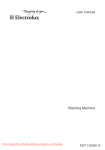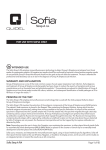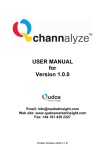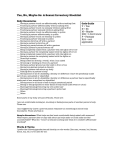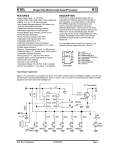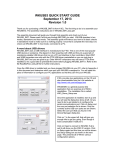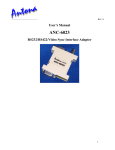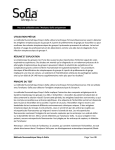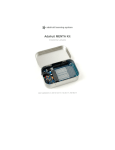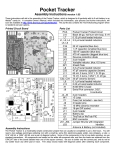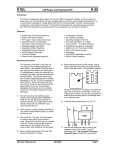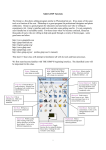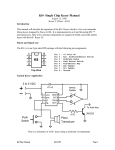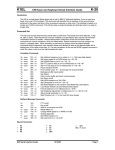Download The PK-3
Transcript
Building and Operating: The PK-3 from Jackson Harbor Press A PIC based keyer kit with pot speed control General notes about building: The components should be inserted a few at a time, soldered in place and then the leads are clipped. Note that all the leads for any particular pad should be inserted prior to soldering to prevent clogging the holes. The pads and traces are small and delicate - a small tipped, low power (25 watts or less) soldering iron should be used. Also, machined pin SIP sockets (not supplied) can be used to provide the connection points to the off-board components, then the builder will be able to plug the wires from the components into the SIP sockets which simplifies moving the unit in and out of the enclosure. Finally, the integrated circuit (IC) and the keying transistor are both MOS devices. This means that they should be handled as little as possible to prevent static damage. The builder should use a grounding strap and anti-static mat if available or at the very least, work on a grounded metal surface and be sure to touch ground prior to touching the ICs. Building the PK-3 - Step 1) Get the parts together: All of the board mounted components have been supplied. You will still have to provide off-board items from the stocklist to fully implement the keyer including the enclosure, speed pot, switch, jacks, battery holder and connector, piezo transducer and mounting hardware. Be sure to get the piezo transducer that requires external drive - basically a very high impedance speaker. Step 2) Identify and orient the components: Most of the components should be fairly easy to identify and place. The .01 uF monolithic ceramic bypass capacitors are very small yellow or blue parts with 2 radial leads spaced .1" apart. You may need a magnifying glass to see the markings on these parts. The four .01 uF bypass caps are marked 103. Note that C6, the pot timing capacitor, is also a .01 uF capacitor but that it is reddish brown in color and has a .2” lead spacing. U2, the 5V regulator, is laser marked and thus hard to read - try to view U2 at an angle in strong light to see the marking. Q1 is clearly marked with the 2N7000 part number. Step 3) Mount and solder the components on the board: diagram for the placement and orientation of the parts. Use the parts placement Start by inserting the 8 pin IC socket with the small notch towards the top of the circuit board and then soldering it in place. Then insert the remaining components at the positions shown on the parts placement diagram. Three of the components should only be inserted one way or they can be damaged by reversed polarity. C2, the 47 uF electrolytic capacitor, should be inserted with the negative stripe to the top side of the board. C2 can also be inserted with the leads bent at a right angle which results in a lower overall height for the board. Q1, the 2N7000 transistor, should be inserted with the flat face to the right of the board. U2, the LM2936 voltage regulator, should be inserted with the flat face to the top of the board. Be sure to solder all the connections and clip leads. Step 4) Check your work: Before proceeding, take the time to check the bottom of the board for solder bridges. Use the Bottom view diagram as a guide to visually check for these shorts. It may help to clean the flux from the board and then use a strong light in conjunction with a magnifying glass to see these problems. Also, double check the orientation of the critical components such as the electrolytic capacitor, transistor and voltage regulator. After you are convinced that the board is OK and after you have formed the leads of the IC to fit in the sockets, insert the keyer IC into the socket, being sure to follow the parts placement diagram for proper orientation. Now hook up the Piezo transducer (beeper) to the connection points on the left side of the board (including a connection to ground. Also solder the 9V battery snap to the top-left side of the board. Next, power up the board. An FB should be sent by the keyer at powerup through the sidetone if the keyer is functioning correctly. Note that you will only hear the FB if the voltage across the 47 uF capacitor is fully discharged - since the keyer IC consumes less than 10 uA of current in sleep mode it can take a long time before the capacitor is fully discharged UNLESS a switch is pressed while the power is off. If you don’t hear the FB, use a VOM to measure the current drawn. With a regulator, the idle current draw after powerup at 9 V should be less than 10 uA. This will jump up to as much as 1.5 mA or so when the keyer is active. If you see significantly higher currents, power down immediately and check again for shorts and/or opens. If the currents look reasonable, then power down and hook the unit up to the switch, pot, paddle and output jack and proceed to the Operation section. The kit has a micropower +5V regulator which allows a user to connect a 9V battery and leave it connected without a power switch. The standby power drawn will be roughly 7 uA. Active power is about 1.5 mA maximum with both paddle switches pressed - a MOSFET is used as the output transistor and this minimizes the active current - also, the sidetone should be connected to a piezo transducer which uses only 50 uA or so. Construction Notes: If the keyer is to be packaged in the same case as the transceiver, it is possible to inject the sidetone directly into the audio chain of the radio instead of using a piezo transducer for the sidetone. The circuitry needed for this injection is a fairly simple RC circuit to decrease the level of the sidetone from 5V peak to peak and also to filter the square wave slightly (see the FREQ-Mite article in the December 1998 issue of QST OR the Norcal 20 article in the Spring 1999 issue of QRPp for more details on this type of circuit). I prefer to mount the keyer in a separate box so that it can be disconnected from the rig and used for practice anywhere. The keyer will fit into small metal boxes such as the old Sucrets boxes or the new, popular Altoids mint tins. One possible problem area for this type of enclosure is finding a pot that is small enough to fit. Mouser (800 346 6873) sells a 13 mm diameter, 100k pot (# 2 31CX501) that fits nicely into one of these types of tins. The small 4 mm shaft size of the pot requires a special knob - Mouser also has these (# 45KN050). If damaged, Q1, the 2N7000 MOSFET output transistor, can be directly replaced by the more common 2N2222 or 2N3904 type NPN transistor. The orientation is the same, however the NPN transistor will require more drive current than the 2N7000 MOSFET. Note that the output transistor circuit is designed to switch key inputs of 13.8 volts positive or less. Don’t attempt to use the PK-3 keyer with a vacuum tube transmitter (either grid block or cathode keyed) without an appropriate outboard circuit - consult older ARRL handbooks for these circuits. For negative keying voltages consider purchasing the Grid Block Keying Adapter kit from Jackson Harbor Press. The minimum pot speed will increase if the power supply voltage decreases below 5 volts. Operation: General notes on using the switches to control the keyer: To give the keys multiple functions, multiple key-press combinations are used. Also, the memory switch can be pressed and released (PAR) OR pressed and held for two seconds (PAH). This also gives more combinations of the three control switches (dit, dah and memory switch). Generally, PAR is used for actions: send the code speed or send a memory. PAH is used for settings: change the code speed (no pot) or record a memory or change the iambic mode. 4 menus are used for setting various options - they are activated by a PAH of the memory switch alone or plus a simulpress of dit or dah or both. The menu selections are made by pressing either the dit or dah levers - you will then normally hear a corresponding dit or dah via the sidetone, the selection will be made and you are then returned back to normal keyer mode. In general, the operator can skip a menu item by a PAR of the mem switch. Note that the keyer sidetone will be higher in pitch (about 900 Hz) for keyer commands such as the menu prompts, recording a memory or the FB sent at powerup. The normal pitch for routine sending or practice is lower at about 600 hz. A function table of the PK-3 keypress combinations: keys used PAR (press and release) PAH (press and hold) mem switch send mem 1 record mem 1 and beacon options mem + dit send speed or mem 3 paddle set of speed, pot options, record mem 3 mem + dah send CQ or callsign Tune, record callsign & CQ options mem + both send mem 2 record mem 2 and miscellaneous options Powerup: Roughly one half second after powerup the keyer will send an FB through the sidetone to signal correct operation. Speed Readout: The speed (in WPM) will be played through the sidetone if the mem switch is simulpressed with the dit lever and then both are released. I normally press the memory switch first and hold it, press the dit lever and finally release both. 3 Speed Control and Menu: The speed can be adjusted by just turning the pot. Maximum speed is 39 WPM, minimum speed is 5 WPM. Note that the minimum speed can be affected by component tolerances on the timing capacitor and the speed pot - see the pot calibration menu item if a 5 WPM minimum speed is required. The pot position is read continuously when the keyer is sending code, just before each dit, dah or space is sent. This allows the operator to adjust the code speed even in the middle of a memory send or record. If you disconnect the pot from the circuit, the keyer will powerup at a default speed of 16 WPM. The speed can be adjusted by pressing and holding the memory switch along with the dit lever. Usually I PAH the memory switch and then tap the dit lever. After 2 seconds, the keyer will send an S (for speed set). Press the memory switch to advance to the next menu item without changing the speed. Or, pressing the dit lever will increase the speed by 1 WPM and send a dit. Pressing the dah lever will decrease the speed by 1 WPM and send a dah. You can continuously adjust the speed by holding either lever but note that if you run the keyer “off the scale” at either 5 or 39 WPM, the keyer will “wrap around” to the opposite speed extreme. Exit the speed adjust routine by pressing and releasing the memory switch - the code speed will be sent via the sidetone upon exit. Mem + dit menu (PAR mem to advance to the next menu item) Menu item pressing a dit: pressing a dah: S Speed set from paddle increases speed by 1 WPM decreases speed by 1 WPM P Pot / paddle speed control selects pot speed control selects paddle speed control C Calibrate pot speed enters the calibration routine dah is ignored control RC Restore pot Calibration restores default pot dah is ignored calibration T Third Memory selects the optional 3rd returns to 2 memories and M memory - O? is sent and then exits menu (default) the third memory is recorded. P - Select Pot or Paddle speed control: If the keyer is accidentally put into the paddle speed control mode the pot speed control can be resumed by pressing dit. C - Calibrating the Pot speed control: Due to the variation in capacitors and pots it is possible that the maximum setting of the pot will result in a minimum speed higher than 5 WPM. This menu item will compensate and store an updated calibration value in RAM. Before entering the menu, be sure to turn the pot to the minimum speed. Then press the dit to go into the calibration routine - you then may hear one or more dits and the keyer will exit from the menu. RC - Restore the default pot Calibration: If the pot calibration is run with the pot above midscale, the keyer may jump into paddle speed control if the pot is then turned below mid-scale after calibration is complete. It won’t be possible to exit paddle speed control 4 because the calibration value is too low. This menu item will restore the default powerup calibration value in RAM and thus allow normal pot speed control again. TM - Third Memory (enable / record / disable): This option enables then records OR disables an optional 3rd memory. Memory 2 is split into two 26 character memories. This new third memory is then played with a mem+dit PAR simulpress. Record memory 3 in the same fashion as the other 2 memories. The speed send is moved into the mem+dit menu as the first item. Press either dit or dah to exit the mem + dit menu after the speed has been sent. Recording the Callsign Memory or using the Menu: A callsign of up to 10 characters long can be recorded. This can be handy for things like: WB9KZY/BCN or WB9KZY/9 . The callsign memory menu is entered by simulpressing the memory and the dah keys and holding them for 2 seconds. I usually PAH the memory switch and then tap the dah key. Mem + dah menu (PAR mem to advance to the next menu item) Menu item Pressing a dit: Pressing a Dah TU TUne mode starts/ends key down dah is ignored ? Record callsign records a dit records a dah memory CS Callsign Select selects a 3 x 3 CQ selects a 4 x 2 CQ (default) Q /QRP after last callsign selects the /QRP option deselects /QRP (default) 2 double the CQ send doubles the CQ send selects a single CQ (default) N No CQ selects send of callsign only selects CQ+callsign (default) TU - Tune mode: After 2 seconds the keyer will send TU. Press the dit lever to enter tune mode (key down). Exit tune mode by a PAR of dit or dah. ? - Record the Callsign Memory: The callsign can now be recorded. When complete, press the memory switch. The routine will be exited automatically after the 10th character is sent. The callsign memory is saved in EEPROM - it will still be there even if power is removed. CS - CQ select: There are two different CQ sequences to select: default (4x2) optional (3x3) CQ CQ CQ CQ DE <call> <c all> K CQ CQ CQ DE <call> <call> <call> K Press dit to select the 3x3 CQ or dah to select the 4x2 CQ. The keyer will send either a dit or dah and then exit the menu. The <call> mentioned above is the callsign memory. Q - /QRP after last callsign: This option will allow the operator to append a /QRP to the last callsign sent - for example: CQ CQ CQ CQ DE WB9KZY WB9KZY/QRP K Press dit to select the /QRP option, press dah to return to the default non-/QRP CQ. The keyer will send either a dit or dah and then exit the menu. 5 2 - double the CQ send: This option will allow the operator to send two CQs in a row for example: CQ CQ CQ CQ DE WB9KZY WB9KZY CQ CQ CQ CQ DE WB9KZY WB9KZY K N - No CQ send: This option will allow the operator to send just the callsign memory with the mem + dah PAR combination. This is effectively a fourth memory for the keyer very handy for contests / pileups. Playing the CQ + Callsign Memory: Play the CQ memory by simulpressing and releasing the memory and the dah keys. I usually PAH the memory switch and then tap the dah lever - the memory starts to play after the memory switch is released. General notes on playing any of the memories: A tap of either the dit or dah lever will stop the message play (except during the playing of /QRP). PAH the mem key during playback to pause the message at the end of the play of the current character, you can then send manually with the paddles and re-enter the message play with a PAR of the mem key. If the memory is empty an E will be sent via the sidetone. General notes on recording Mem 1 and 2: Note that you can insert the callsign memory at any given point in the message by sending 6 dahs in a row. You can also insert a pause into the memory by recording the AS (di-dah-di-di-dit) character. Message play will stop when an embedded pause is reached - the paddle can then be used to send something manually - the message play can then be resumed with a PAR of the mem key. This is useful for inserting an RST or a serial number into a message. You can also embed a space of 6 dits in length by entering a special character of di-dahdah-dah-dit. Note that spaces do count as characters in the capacity of a memory. You can insert the callsign memory, pause or space multiple times - each insertion takes up one character in memory. Playing Mem 1: Play the memory with a PAR of the memory switch. The memory will start to play right after the memory switch is released. Recording Mem 1 and Menu: The Mem 1 menu can be entered by a PAH of the mem switch (alone) for 2 seconds. After 2 seconds the keyer will enter the menu (you’ll hear a BE). BE M? KD BA D Mem switch menu (PAR mem to advance to the next menu item) Menu item pressing a dit: pressing a dah: BEacon mode starts the beacon going dah is ignored Record Mem 1 records a dit records a dah Key Down beacon delay selects key down during the selects key up (default) delay between memory during delay between sends memory sends Beacon Alternate mode selects alternate beacon selects send of mem 1 only sends of mem 1 and mem 2 (default) increase the beacon increases delay by 1 second decreases delay by 1 second Delay BE - Beacon Mode: Beacon mode will send the contents of mem 1 continuously with a selectable (see D below) pause in between each play of the memory. Start the beacon by pressing the dit lever the beacon starts to play. Exit beacon mode by tapping the dit or dah lever. 6 M? - Record Mem 1: Start sending your message. when complete, press the mem key. The memory is 57 characters long - recording will terminate automatically after the 52nd character. KD - Key Down beacon delay: Press dit to select the key down beacon delay mode. This will enable the sending of a constant key down during the interval between sending the beacon message. Press dah to return to the default key up beacon delay. The keyer will send either a dit or dah and then exit the menu. BA - Beacon Alternate between mem 1 and mem 2 mode: This routine selects/deselects alternating the beacon between mem1 and mem 2. D - increase the beacon delay: Normally, the beacon delay will be a single word space (0 seconds). The maximum beacon delay is 60 seconds. After pressing either dit or dah the keyer will send the delay time through the sidetone. When you get to the desired delay time, press the memory switch to exit from the menu - the keyer will send the delay length one final time through the sidetone. The routine will “wraparound” from high to low OR from low to high delay values similar to the paddle speed control. Note that the delay times are approximate. Playing Mem 2: First, hold the mem switch down, next, squeeze both paddle levers (they both must be down at the same time) then release the paddle and finally release the mem switch before 2 seconds elapse. The memory will start to play right after the mem switch release. Recording Mem 2 and Menu: The second message of up to 52 characters long can be recorded by a PAH of the mem switch and both paddle levers for 2 seconds. Hold the mem switch down, then squeeze both paddle levers simultaneously (they both must be down at the same time), then release the paddle, keep holding the mem switch until after 2 seconds the keyer will sendT?. Mem 2 can now be recorded. When recording is complete, press the mem switch. If you wish to skip recording just press and release the mem switch alone to proceed to the next menu item: Mem + both menu (PAR mem to advance to the next menu item) Menu item pressing a dit: pressing a dah: T? Record mem 2 records a dit records a dah PR Practice mode disables the output transistor enables the output (default) B Bug / straight key enables bug mode (dah = key) disables bug mode (default) mode L Live / dead recording enables keyer output when disables live output (default) recording a memory A iambic mode A or B enables iambic mode A enables mode B (default) R Reverse paddle mode switches dit and dah levers switches dit and dah levers ST SideTone on / off turns off the sidetone turns on the sidetone (default) SF Sidetone Float mode floats pin 3 between turns off float (default) characters DI DIt memory on / off turns off the dit memory turns on dit memory (default) DA DAh memory on / off turns off the dah memory turns on dah memory (default) AU Autospace on / off turns on character autospace turns off autospace (default) 7 PR - Practice mode: The output transistor is not keyed but the sidetone is retained. This allows the user to get used to the PK-3 without having to disconnect the rig. B - Bug / Straight-key mode: Dits are sent normally but dahs are sent like a straight key. L - Live or Dead recording: Normally, the memory or callsign will be recorded by the user off the air (dead) but sometimes it’s desirable to be able to record a message on the air (live). A - Iambic mode A or B: The A mentioned above signifies the mode A/B select menu item. The iambic mode of the keyer can be set to either mode using this routine. Check the JHP web site for an Acrobat (.pdf) file which explains the difference between the A and B keying modes. R - Reverse paddle mode: Reverses the dit and dah levers (easier than resoldering a jack). ST - SideTone on/off: The sidetone will still be engaged during any menu or recording entry even if it is turned off with this menu item - this item allows the user to employ his rig sidetone. Pressing the mem key at powerup of the keyer will turn off the sidetone (release after FB is sent). SF - Sidetone Float on/off: The reason for floating the sidetone pin is to minimize thump from the sidetone when the PK-3 chip is used to inject sidetone into a rig audio chain (example: 38 Special or Norcal 20). The float should normally be DISABLED when using a piezo sidetone to prevent excessive power supply current in the sleep mode. DI - DIt memory on/off: DA - DAh memory on/off: Normally the keyer has both dit and dah memories enabled - at higher speeds (30 WPM or more), some users may like “less” memory. The dit and dah memories are evident if the dit and dah paddles are pressed rapidly in order at low speed. If the dah memory is on, an A will be sent. If the dah memory is off, an E (single dit) is sent. AU - AUtospace on/off: The autospace feature inserts a character space (1 dah in length) automatically if the operator has not pressed a paddle switch 1 dit space after the last dit/dah sent. This feature is always on in the memory record routines (needed for the recording process). Notes: C2, the 47 uF capacitor, will retain power on the keyer chip for quite a while even without the 9V battery connected. This can cause trouble if the keyer gets hung up because any scrambled RAM memory will be retained. To clear scrambled memory, remove power and then short out this capacitor. Since all the memory contents (except the callsign) are contained in the RAM, all will be lost if the keyer is completely powered down. The callsign and the configuration settings are contained in EEPROM - to reset all of these to the default value, powerup the keyer with the mem switch depressed until the FB is sent. PK-3 Stocklist Qty. 1 1 2 4 1 1 1 1 8 Ref. U1 U2 C1,C8 . C3,C4,C5,C7 C6 C2 R2 R3 Part Name 12CE674 LM2936 22 uF .01 uF .01 uF 47 uF 4.7 K ohm 1 K ohm Description PK-3, 8 pin DIP keyer chip - Microchip Technology 5V ultra low standby current regulator, TO-92 pkg. marked 224 - axial multi-layer ceramic capacitor marked 103 - .1” lead space multi-layer ceramic capacitor marked 103 - .2” lead space, 5% polyester capacitor .079” lead space 25V electrolytic capacitor Yellow-violet-red - 1/4 watt metal film resistor Brown-black-red - 1/4 watt metal film resistor 1 1 1 1 R4 Q1 - 180 ohm 2N7000 socket PCB Brown-gray-brown - 1/4 watt metal film resistor TO-92 package MOSFET transistor 8 pin DIP socket (machine pin) PIC Keyer circuit board The following items are NOT included with the kit: 1 R1 100 K ohm Linear potentiometer 1 knob for pot R1 1 Piezo transducer Digi-key P9924-ND or equivalent 1 J1,J2 stereo paddle jack 1 xmtr jack 1 9 volt battery “snap” connector 1 SW1 normally open, momentary SPST switch Copyright © 1999 by Charles J. Olson, Jackson Harbor Press RR1, Box 91C Washington Island, WI 54246 http://home.att.net/~jacksonharbor please email questions & suggestions to: [email protected] 9









